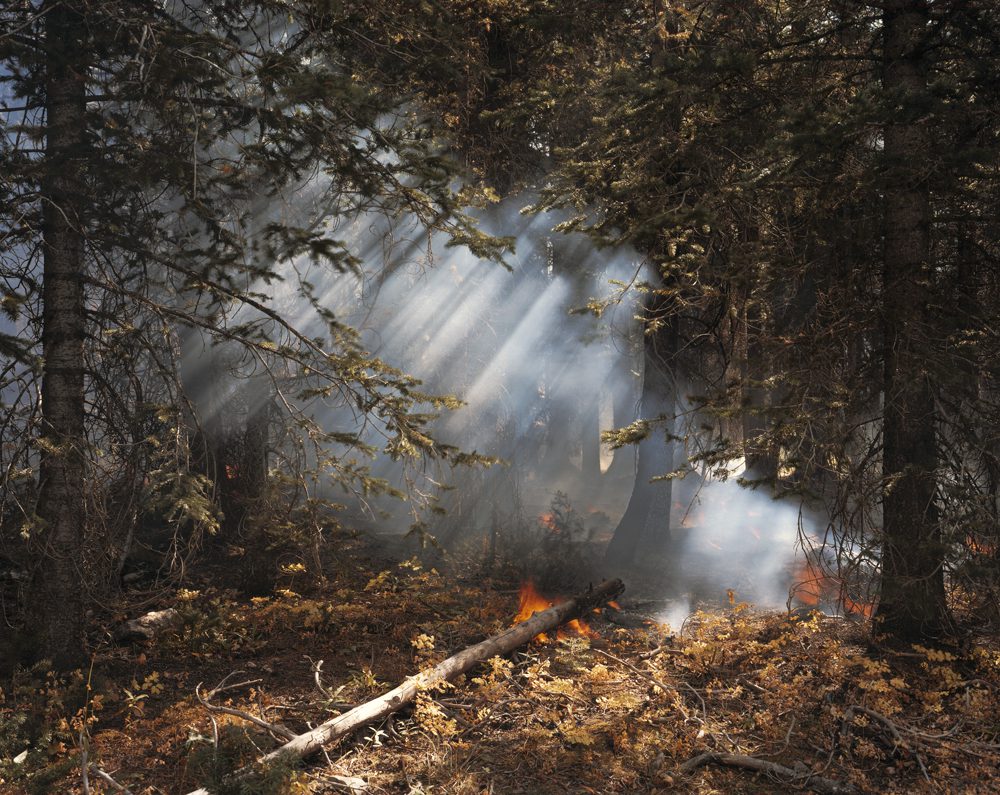Raging Fires, Rising Waters
As part of our series on living with water, Nathan C. Martin reflects on being a wilderness guide and the increasingly extreme wildfires and floods across the country.

Laura McPhee, Understory Flareups, Fourth of July Creek, Valley Road Wildfire, Custer County, Idaho, 2005. Archival pigment print. Courtesy the artist and [Benrubi Gallery]( http://benrubigallery.com/gallery/65/river-no-return), New York.
My boss is a small, stout hippie prone to shirtlessness. I found him one day late last June in the parking lot outside our headquarters, stretching his tan limbs in the sun like a cat, weird little pigtails poking out from beneath his trucker hat.
“Did you see the forecast? Like, 75 and sunny all week. Zero percent chance of rain,” he said. He grinned, rolled his shoulders, and walked off to tinker with one of his boats.
I’m a guide in Yellowstone and Grand Teton National Parks, taking clients on multi-day trips into the Wyoming wilderness. We travel mostly by kayak, expeditioning between island campsites and mountain day hikes. As we paddle, a slow and steady support boat putters behind us, piled high with sturdy tents, an entire kitchen we construct at each camp, and fixings for delicious backcountry feasts.
It’s glamping, to be sure. But high in the Rockies, even summer trips can turn cold and nasty. A sunny week with no rain means not having to build a shelter above the kitchen as we cook. It makes swimming in cold alpine lakes appealing. And it means daytimes of comfortable warmth segue into slightly crisp, clear nights under skies so chock full of stars that falling meteorites seem to be expelled out of sheer overabundance.
The first week of nothing but sun was perfect. So was the second. By the third, though, I began to worry. Pine needles crackled under our boots as we hiked, huckleberry bushes drooped and browned, and the ground of our campsites’ well-trod common areas became churned into chalky dust.
A month into the dryness, fires erupted.
Summer has always been fire season in the West, but the intensity of wildfires here has become out of control. According to the National Interagency Fire Center, based in Boise, Idaho, the five worst wildfire years on record all took place in the past decade. In 2015, 11 million acres burned in the United States, an area larger than Denmark. In October, climatologists released a study linking this infernal proliferation to the hotter, drier temperatures we’ve experienced as a result of human-caused climate change.
The first two fires near me—the Cliff Creek and Berry Fires—burned south and southeast, respectively, of the parks where I work. Officials closed the highway when the Cliff Creek Fire jumped the road, stranding one of my fellow guides and forcing me to run a couple short trips solo. Then fires started in the parks themselves, further restricting travel—on one trip, my clients and I were forced to make a seven-hour detour by van to circumvent a route closed by a blaze. Depending on the wind, the air around the Tetons sometimes became so thick with smoke the peaks were indecipherable from more than a few hundred yards. At night, we watched the orange glow fester among the forested ridges.
Wilderness guiding can be a weird job for a news junky like me. At the end of each trip, I’m keen to learn what world events I’ve missed. In August 2014, the day before I left on one outing, I read of unrestful murmurs outside St. Louis, where police had killed a young unarmed black man. By the time I got back to civilization, the seeds of Black Lives Matter had begun to riotously bloom.
This summer, I returned from a trip with smoke-fatigued lungs to reports of Louisiana underwater. My Facebook feed was full of friends in New Orleans spreading news of support networks connecting flood victims with places to stay. Articles on the deluge also implicated global warming, and although images of people wading through sodden streets in Louisiana are becoming as normal as the burning West, the juxtaposition felt surreal. The trip I’d just finished saw one of the summer’s only bouts of precipitation—not rain, but hail. We were on a hike when marble-sized balls of ice began to fall. As our well-heeled clients scrambled for cover amidst the pine trees, the guides danced giddily out of excitement that at least something, at last, was wetting our long-parched forests.
The weather, like our collective wealth and national politics, has stratified, discarding mild seasons to befit these radical times. And this summer, while I wished through split lips that floodwater from the South could migrate West somehow to create some semblance of equilibrium, a force to the north coalesced to actually address the problem. Everyone knows what’s happening at Standing Rock: People are working to protect the water in order to save the world. We will follow their lead or perish.
Summer became fall and snow started sprinkling the West, tempering most of the wildfires. (Meanwhile, the South dried out and is burning while I write this.) But snows that quell flames also fall on the camps where water protectors are steeling themselves for the long winter, preparing at once for subzero temperatures, increasingly militarized police, and a suicidal incoming presidential administration hostile to both water and the life it supports. We will need to replicate actions like Standing Rock ad nauseum for the foreseeable future—it’s one new aspect among many of our experiences moving forward, as we re-learn to live with water, live with fire, and figure out how to continue to exist.



